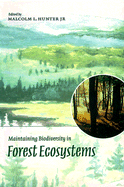Book contents
- Frontmatter
- Contents
- List of contributors
- Foreword
- Preface
- Part I Introduction
- Part II The macro approach, managing forest landscapes
- 3 Species composition
- 4 Dynamic forest mosaics
- 5 Abiotic factors [161]
- 6 Forest edges
- 7 Islands and fragments
- 8 Riparian forests
- 9 Forested wetlands
- Part III The micro approach, managing forest stands
- Part IV Synthesis and implementation
- Index
7 - Islands and fragments
Published online by Cambridge University Press: 20 February 2010
- Frontmatter
- Contents
- List of contributors
- Foreword
- Preface
- Part I Introduction
- Part II The macro approach, managing forest landscapes
- 3 Species composition
- 4 Dynamic forest mosaics
- 5 Abiotic factors [161]
- 6 Forest edges
- 7 Islands and fragments
- 8 Riparian forests
- 9 Forested wetlands
- Part III The micro approach, managing forest stands
- Part IV Synthesis and implementation
- Index
Summary
Many forests exist as small stands isolated from other stands by intensively modified land such as fields, pastures, clearcuts, and silvicultural plantations. In many parts of the world isolated patches are all that is left of a formerly continuous forest cover. There is no doubt whatever that such a change in forest structure brings forth harmful ecological changes. My aim in this chapter is to review what is known about such changes and suggest ways to mitigate the consequences through appropriate management.
The process through which formerly continuous forest expanses turn into forest patches of varying size, isolated from each other by tracts of non-forested land, is called fragmentation. The resulting configuration often resembles an ‘archipelago’ in which forest ‘islands’ are surrounded by a ‘sea’ of another type of environment. This commonly drawn analogy between forest fragments and real islands has a background in the development of ecological theory: research on the ecology of discrete forest patches has been inspired by research on the ecology of real islands, in particular, by the theory of island biogeography of MacArthur and Wilson (1967) and its predecessors (see Williamson 1981). I will argue later in this chapter that a strict analogy is misleading but, nevertheless, there are similarities that make a comparison fruitful.
The most important factor driving forest fragmentation, by far, has been agriculture. Historically, agriculture has spread unevenly. The rate of conversion of natural vegetation to agriculture reached in many parts of the world record levels in the twentieth century, particularly after World War II.
- Type
- Chapter
- Information
- Maintaining Biodiversity in Forest Ecosystems , pp. 234 - 264Publisher: Cambridge University PressPrint publication year: 1999
- 47
- Cited by

